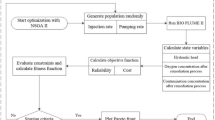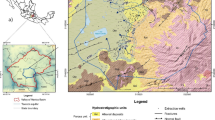Abstract
A methodology is proposed for optimal design of groundwater quality monitoring networks under epistemic uncertainty. The proposed methodology considers spatiotemporal pollutant concentrations as fuzzy numbers. It incorporates fuzzy ordinary kriging (FOK) within the decision model formulation for spatial estimation of contaminant concentration values. A multiobjective monitoring network design model incorporating the objectives of fuzzy mass estimation error and spatial coverage of the designed network is developed. Nondominated Sorting Genetic Algorithm-II (NSGA-II) is used for solving the monitoring network design model. Performances of the proposed model are evaluated for hypothetical illustrative system. Evaluation results indicate that the proposed methodology perform satisfactorily under uncertain system conditions. These performance evaluation results demonstrate the potential applicability of the proposed methodology for optimal groundwater contaminant monitoring network design under epistemic uncertainty.














Similar content being viewed by others
References
Ababou R (1988) Three-dimensional flow in random porous media” Ph.D. Thesis, Massachusetts Institute of Technology, Cambridge, Massachusetts, [URL: http://hdl.handle.net/1721.1/14675]
Affandi A, Watanabe K (2007) Daily groundwater level fluctuation forecasting using soft computing technique. Nature Science 5(2):1–10
Afshar A, Maririo M, Ebtehaj M, Moosavi J (2007) Rule-based fuzzy system for assessing groundwater vulnerability. J Environ Eng 133(5):532–540
American Society of Civil Engineers Task Committee on Long-Term Groundwater Monitoring Design (2003) Long-term groundwater monitoring: the state of the art. Reston, VA
Bandemer H, Gebhardt A (2000) Bayesian fuzzy kriging. Fuzzy Set Syst 112:405–418
Bardossy A, Bogardi I, Kelly WE (1987) Imprecise (Fuzzy) information in Geostatistics. Math Geol 20(4):287–309
Bardossy A, Bogardi I, Kelly WE (1990a) Kriging with imprecise (Fuzzy) variograms I: theory. Math Geol 22(1):63–79
Bardossy A, Bogardi I, Kelly WE (1990b) Kriging with imprecise (Fuzzy) variograms II: application. Math Geol 22(1):81–94
Bisht DCS, Raju M, Joshi M (2009) Simulation of water table elevation fluctuation using fuzzy-logic and ANFIS. Comput Model New Tech 13(2):16–23
Chadalavada S, Datta B (2008) Dynamic optimal monitoring network design for transient transport of pollutants in groundwater aquifers. Water Resour Manag 22:651–670
Datta B, Dhiman SD (1996) Chance-constrained optimal monitoring network design for pollutants in groundwater. J Water Resour Plann Manag 122(3):180–188
Datta B, Chakrabarty D, Dhar A (2009a) Simultaneous identification of unknown groundwater pollution sources and estimation of aquifer parameters. J Hydrol 376(1–2):48–57
Datta B, Chakrabarty D, Dhar A (2009b) Optimal dynamic monitoring network design and identification of unknown groundwater pollution sources. Water Resour Manag 23(10):2031–2049
Datta B, Chakrabarty D, Dhar A (2011) Identification of unknown groundwater pollution sources using classical optimization with linked simulation. J Hydro-env Res 5(1):25–36
Deb K (2001) Multi-objective optimization using evolutionary algorithms. John Wiley & Sons, Ltd, Singapore
Deutsch CV, Journel AG (1998) GSLIB: geostatistical software library and user’s guide. Oxford University Press, New York
Dhar A, Datta B (2007) Multiobjective dynamic monitoring network design for groundwater pollution detection. J Water Resour Plann Manag 133(4):329–338
Dhar A, Datta B (2009) Global optimal design of ground water monitoring network using embedded kriging. Ground Water 47(6):806–815
Dhar A, Datta B (2010) Logic based design of groundwater monitoring network for redundancy reduction. J Water Resour Plann Manag 136(1):88–94
Diamond P (1988) Interval valued random functions and the kriging of intervals. Math Geol 20(3):145–165
Diamond P (1989) Fuzzy kriging. Fuzzy Set Syst 33:315–332
Dixon B (2004) Prediction of ground water vulnerability using an integrated GIS based Neuro-Fuzzy techniques. J Spat Hydrol 4(2):1–38
Dou C, Woldt W, Bogardi I, Dahab M (1995) Steady state ground water flow simulation with imprecise parameters. Water Resour Res 31(11):2709–2719
Duarte O, Rosario R (2007) Fuzzy techniques for environmental-impact assessment in the mineral deposit of punta Gorda (Moa,Cuba). Environ Technol 28(6):659–669
Goovaerts P (1997) Geostatistics for natural resources evaluation. Oxford University Press, New York
Harbaugh AW, Banta ER, Hill MC, McDonald MG (2000) MODFLOW-2000, the US Geological Survey modular ground-water model-user guide to modularization concepts and the ground-water flow process. US Geological Survey Open-File Report 00–92
Herrera GS, Pinder GF (2005) Space-time optimization of groundwater quality sampling networks. Water Resour Res 41:W12407
Huang Y, Wong P, Gedeon T (1998) Spatial interpolation using fuzzy reasoning and genetic algorithms. J Geogr Inform Decis Anal 2(2):204–214
Huang GH, Qin XS, Xiao HN, Li YP (2007) Environmental risk assessment for groundwater contamination through integrated fuzzy techniques. Env Info Arch 5:1–7
Kholghi M, Hosseini SM (2009) Comparison of groundwater level estimation using neuro-fuzzy and ordinary kriging. Environ Model Assess 14:729–737
Kollat JB, Reed PM (2007) A computational scaling analysis of multiobjective evolutionary algorithms in long-term groundwater monitoring applications. Adv Water Resour 30(3):408–419
Kollat JB, Reed PM, Kasprzyk JR (2008) A new epsilon-dominance hierarchical bayesian optimization algorithm for large multi-objective monitoring network design problems. Adv Water Resour 31(5):828–845
Loaiciga HA, Charbeneau RJ, Everett LG, Fogg GE, Hobbs BF, Rouhani S (1992) Review of ground-water quality monitoring network design. J Hydraul Eng 118(1):11–37
McDonald MG, Harbaugh AW (1988) A modular three-dimensional finite-difference ground-water flow model. USGS Techniques of Water-Resources Investigations, Book 6, Chapter A1
Meyer PD, Brill ED Jr (1988) A method for locating wells in a groundwater monitoring network under conditions of uncertainty. Water Resour Res 24(8):1277–1282
Mugunthan P, Shoemaker CA (2004) Time varying optimization for monitoring multiple contaminants under uncertain hydrogeology. Bioremediation Journal 8(3–4):129–146
Muhammetoglu A, Yardimci A (2005) A fuzzy logic approach to asses ground water pollution environmental monitoring and assessment. Water Resour Manag 118(2):337–354
Ozbek MM, Pinder GF (2006) Non-probabilistic uncertainty in subsurface hydrology and its applications: an overview. Water Air Soil Pollut Focus 6(1–2):35–46
Qin XS, Huang GH, Chen B (2006) Environmental risk assessment for groundwater contamination through integrated fuzzy techniques. Env Info Arch 4:82–87
Reed P, Minsker BS (2004) Striking the balance: long-term groundwater monitoring design for conflicting objectives. J Water Resour Plann Manag 130(2):140–149
Sunila R, Laine E, Kremenova O (2004) Fuzzy model and kriging for imprecise soil polygon boundries. Geospatial Information Research: Bridging the pacific and Atlantic, University of Gavle,Sweden, pp 489–495
Wu J, Zheng C, Chien CC, Zheng L (2006) A comparative study of Monte Carlo simple genetic algorithm and noisy genetic algorithm and noisy genetic algorithm for cost-effective sampling network design under uncertainty. Adv Water Resour 29(6):899–911
Zhang Y, Pinder GF, Herrera GS (2005) Least cost design of groundwater quality monitoring networks. Water Resour Res 41:W08412
Zheng C, Wang PP (1999) MT3DMS, a modular three-dimensional multi-species transport model for simulation of advection, dispersion and chemical reactions of contaminants in groundwater systems; documentation and user's guide. U.S. AERDCC Report SERDP-99-1, Vicksburg, MS
Author information
Authors and Affiliations
Corresponding author
Rights and permissions
About this article
Cite this article
Dhar, A., Patil, R.S. Multiobjective Design of Groundwater Monitoring Network Under Epistemic Uncertainty. Water Resour Manage 26, 1809–1825 (2012). https://doi.org/10.1007/s11269-012-9988-1
Received:
Accepted:
Published:
Issue Date:
DOI: https://doi.org/10.1007/s11269-012-9988-1




